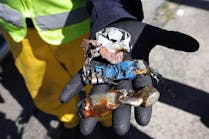Fires in Older Buildings Create Challenges for SD Crews
By Elisa Sand
Source American News, Aberdeen, S.D.
A key for firefighters battling a blaze is knowing the architecture of the building that’s on fire and the potential challenges they will face.
Aberdeen Fire & Rescue Battalion Chief JR Huebner and Fire Chief Randy Meister said older residential and business buildings often have void spaces where fire can hide or travel from the basement to the attic.
This was just one of the challenges with a fire last month at the Malchow’s Home Furnishings building. What firefighters thought was an apartment fire was actually a fire raging within the void space between the building’s first and second floors.
No matter where firefighters went, Huebner said, they couldn’t get ahead of the fire.
To many onlookers who arrived on the scene shortly after the flames started, it likely looked like they had been contained relatively early in the evening. But the flames eventually reemerged and lasted late into the night. Ultimately, the building was so badly damaged it had to be demolished.
With fire in the ceiling and on the floor, soon the call was made to pull firefighters out of the building and tackle it from the outside, Huebner said. Any store workers and second-floor apartment tenants were out of the building, so the risk to the six to eight firefighters inside the structure wasn’t worthwhile, Meister said.
Though many older business buildings have a brick exterior, Huebner said, they’ve also got wood framing inside, which provide plenty of fuel for a fire. And, Meister said, the older the building, the dryer that timber is.
“Fire loads in older buildings are pretty heavy,” Meister said. “You would have never guessed it with Malchow’s.”
Void spaces can be created during remodeling with the installation of a lower ceiling or new wiring or utilities. Often the old wiring is left in place. Meister said the spaces for those old utility lines can create a path for the fire. It’s not the fault of the contractor remodeling the building, he said, but it is something firefighters need to be cognizant of.
Meister said challenges also arise when windows in older buildings get bricked over or barred. That was the case in a building on South Kline Street that caught on fire. Bricking or barring windows limits access to the building, and bars significantly limit emergency exit options for firefighters. Huebner said equipment is always on hand to cut the bars from the windows, but that takes time.
Paying attention to new construction and knowing where hazardous chemicals are stored is also important. Meister said notes are kept on where chemicals are stored in industrial buildings. And when new buildings go up, firefighters take any opportunity they can to walk through them to see how they are being built.
Time is of the essence in any fire. In the case of Malchow’s, the fire had an early start. Investigators determined the fire was likely burning in the void space for about three and a half hours before it broke through the apartment floor and smoke started billowing out into the hallway, alerting people who lived upstairs.
Huebner said it helps to know about home construction when there’s a fire. How it’s changed through time some homes can pose challenges. Fires that start in the basement of some homes, he said, can get into the wall and travel up to the attic before they’re noticed.
“We pull up and it looks like an attic fire, but it’s in the basement,” he said.
Huebner said those instances typically involve “balloon frame” construction popular in homes from the 1940s and 1950s. Such homes are found in central Aberdeen, near the Northern State University campus and on the north side of town.
With balloon framing, long two-by-fours extend from the top of the foundation to the roof. The long pieces of wood can allow flames can spread from the basement to the attic quickly without obstruction.
Because the source of a fire can be different from what it appears, Huebner said, it’s important to evaluate the building first and check the basement even if it looks like the fire is in the roof. That’s why casual observers may notice firefighters don’t immediately grab a hose and start dousing flames.
Priority one is always searching for people inside a structure and making sure everyone is out, Huebner said. The next step is looking for the source of the fire.
Knowing where the best sources of water are is also important. Water mains in Aberdeen can vary from 12 inches in diameter on Main Street to 6 inches in residential areas. The age of the piping also varies. Meister said that’s why annual checks of fire hydrants are important. And, he said, there’s a reason hydrants are different colors. Blue paint on a fire hydrant, for instance, indicates a connection to a larger water main. Green, orange and red indicate progressively smaller lines.
Meister said every fire call needs to be treated as an emergency. It doesn’t matter if it’s the third smoke alarm call at the same building within 24 hours. As soon as assumptions are made, he said, that’s when it will be a true emergency.
———
©2019 the American News (Aberdeen, S.D.)
Visit the American News (Aberdeen, S.D.) at www.aberdeennews.com
Distributed by Tribune Content Agency, LLC.






